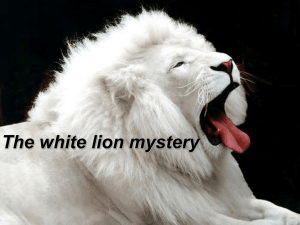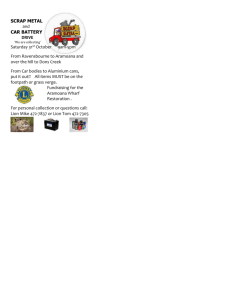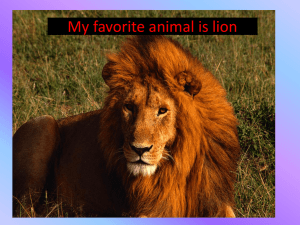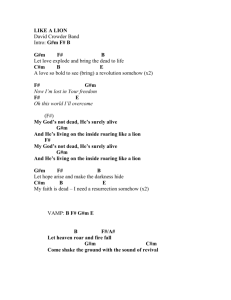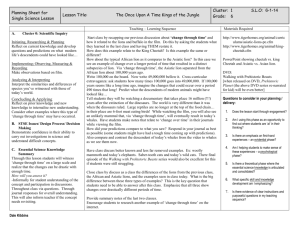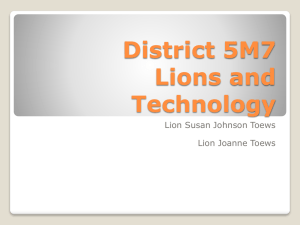Their Abundance, Density and Ecology
advertisement
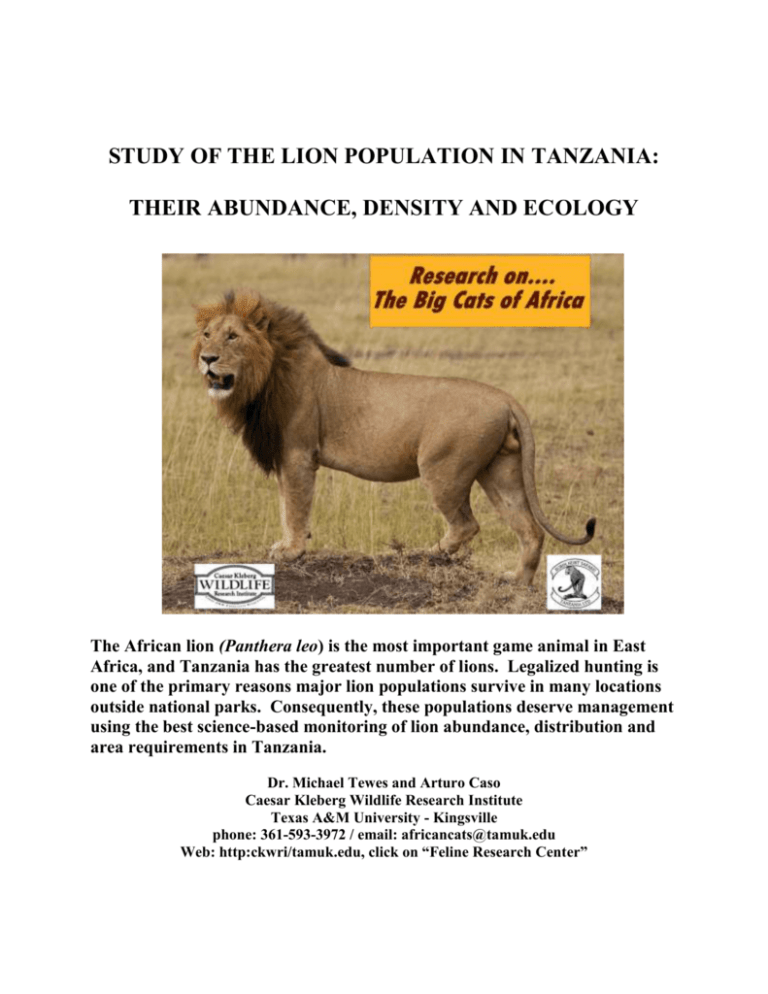
STUDY OF THE LION POPULATION IN TANZANIA: THEIR ABUNDANCE, DENSITY AND ECOLOGY The African lion (Panthera leo) is the most important game animal in East Africa, and Tanzania has the greatest number of lions. Legalized hunting is one of the primary reasons major lion populations survive in many locations outside national parks. Consequently, these populations deserve management using the best science-based monitoring of lion abundance, distribution and area requirements in Tanzania. Dr. Michael Tewes and Arturo Caso Caesar Kleberg Wildlife Research Institute Texas A&M University - Kingsville phone: 361-593-3972 / email: africancats@tamuk.edu Web: http:ckwri/tamuk.edu, click on “Feline Research Center” Sustainable hunting of lions has received considerable attention in recent years. Some advocates assert that the lack of information about population status, abundance and monitoring are reasons that lion hunting should be curtailed. There is the risk that the CITES status for the lion will change from Appendix II to Appendix I based on insufficient data and will negatively curtail the conservation benefits provided by safari hunting in Tanzania. Management and conservation of lions should use the best science-based information available. In support of this premise, we will conduct a 4-year study of targeted lion populations in Central Tanzania. Our results will benefit lion management and sustainable trophy hunting in Tanzania and other regions. PROJECT PHASE AND METHODS We are proposing a study to assess population status, population abundance and spatial ecology of lions in Central Tanzania. Information about lion prey, leopards and the other carnivores will also be collected opportunistically using remote cameras. Initial work will focus on the Rungwa and Luganzo Game Reserves. The Rungwa ecosystem of central Tanzania covers over one million hectares, and is one of the most remote areas in East Africa. The cover types includes the Miombo woodlands, riparian forests and open savannas. Phase I will implement scientifically rigorous survey techniques (e.g., structured call counts, photo mark-recapture methods) to estimate lion population abundance and distribution (Funston et al. 2003) in Rungwa and Luganzo Game Reserves of Central Tanzania. Details of the methods for Phase I are provided herein. (Year 1) Phase II will explore the ecology of lions in the Miombo woodlands of Rungwa Game Reserve using advanced GPS collars and molecular genetics to evaluate the spatial ecology and abundance of lions. This information will help calibrate estimates of population abundance and density. In addition, critical area requirements will be determined by this research. (The population monitoring established in Phase I will continue during Phase II.) (Year 2-4). Population surveys will use calling stations throughout the study area. Calling stations with lion and hyena feeding sounds and buffalo distress calls will be used to attract lions for identification. Attempts will be made to identify individual lions with photographs, video and infrared video taken at calling stations. Unique marks, scars and whisker patterns will be used to assist identification of individuals. Positions for these calling stations will be determined a priori by means of GIS and also a 5 x 5 km grid super-imposed on a 1:125,000 scale map of the Luganzo and Rungwa Game Reserves. To allow for approximate total effective area coverage, one calling station for every 25 km2 will be required. Individual calling stations will be at least 10 km apart to ensure effective separation. This separation is based on known distance of the general effectiveness of sound recordings (3-5 km) (Funston et al. 2003). A maximum of four calling stations per night will be used, approximate calling times will be from about 1900 h to 0100 h with 30-60 minutes allowed for moving between calling site locations, each with a one-hour duration of continuous calling. Primary surveys of the study area will be conducted during the dry season (i.e., June-September) because the response to calling stations has been tested and found to be higher during this season. Data will also be collected to calibrate the calling station survey method for each area. Digital remote sensing cameras will be also set on a grid system to estimate lion and other wildlife species density. All data will be entered into an appropriate computer database and programs such as CAPTURE and MARK will be used to determine population density. Lions will be classified according to age and sex with attempts to identify each individual lion. Presence of other large carnivores (e.g., hyenas) will also be recorded to assess their population size and to characterize general carnivore diversity. Calling station data will be supplemented with additional observations and relevant data whenever possible (e.g., lion spoor, roaring counts, remote sensing cameras, Professional Hunter records, etc.) to obtain an indication of possible additional lions not recorded during the survey. To maintain sampling consistency and to minimize bias, calling stations will not be used under adverse weather conditions such as during strong wind, rain or thunderstorms. THE FELINE RESEARCH CENTER Dr. Michael Tewes began cat research at the Caesar Kleberg Wildlife Research Institute in 1981, and has supervised many cat projects over the past 30 years. Mr. Arturo Caso joined the Kleberg Institute in 1990 and has collaborated for over 20 years. Their research has yielded over 170 scientific presentations, 70 scientific publications and four publication awards from peers. These accomplishments reflect the high-level of credibility assigned to the Feline Research Center. Principle Investigator: Dr. Michael Tewes is a Regents Professor and holder of the Frank Daniel Yturria Endowed Chair for Wild Cat Studies at Texas A&M University-Kingsville and the Caesar Kleberg Wildlife Research Institute. Michael has conducted field projects studying 10 different species of wild cats and several other carnivores in the United States and Asia. Species studied include ocelot, bobcat, jaguarundi, mountain lion, clouded leopard, Asiatic golden cat and marbled cat. Principle Field Biologist: Arturo Caso is a Research Associate for Texas A&M UniversityKingsville and the Caesar Kleberg Wildlife Research Institute. Arturo went to his first hunting Safari when he was 17-years-old and has returned several times. He developed highly-efficient techniques to capture and attach GPS collars on several leopards in Tanzania . Arturo has conducted field studies on wild cats in Mexico, the U.S. and Africa including jaguar, ocelot and jaguarundi. SUPPORTERS AND COLLABORATORS Robin Hurt Safari is a premier safari company providing important field support for this lion study. Their generous support of our earlier study using GPS collars on leopards in Tanzania provided important information about this important trophy species and their spatial patterns during the dry season. Dr. Paul Funston will collaborate and provide important guidance regarding the survey methodology of which he has previously published. Dr. Funston is a professor at Tshwane University of Technology in Prtetoria, South Africa. DONATIONS Results of our study will be essential for science-based lion management and conservation of lions in Tanzania and elsewhere. Consider giving a donation to help maintain sustainable populations of lions in Africa; please make checks payable to “African Cats Research CKWRI” and mail to: Dr. Michael Tewes Caesar Kleberg Wildlife Research Institute MSC 218, 700 University Blvd. Texas A&M University-Kingsville Kingsville, TX 78363 Phone: 361-593-3972 Fax: 361-593-3924 Email: africancats@tamuk.edu Web: http:ckwri/tamuk.edu then click on “Feline Research Center”

